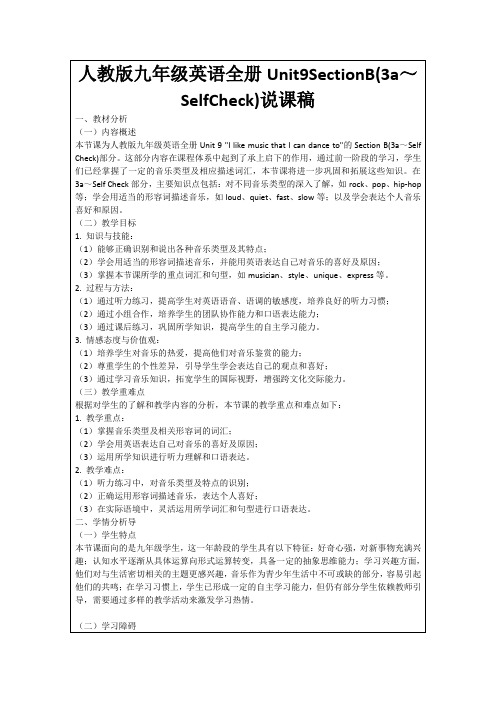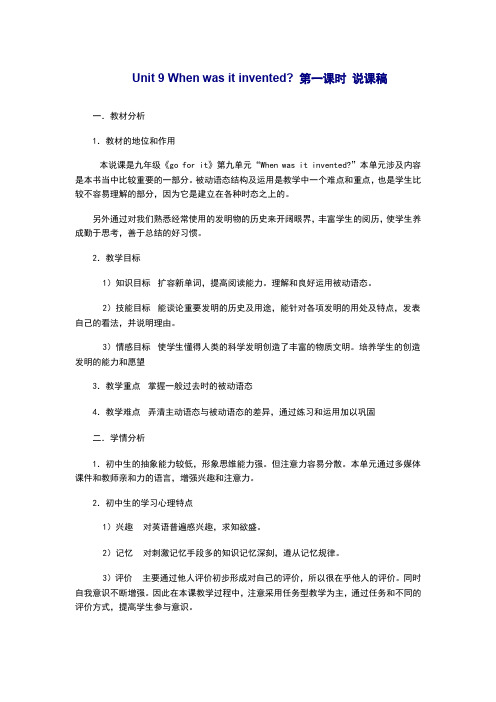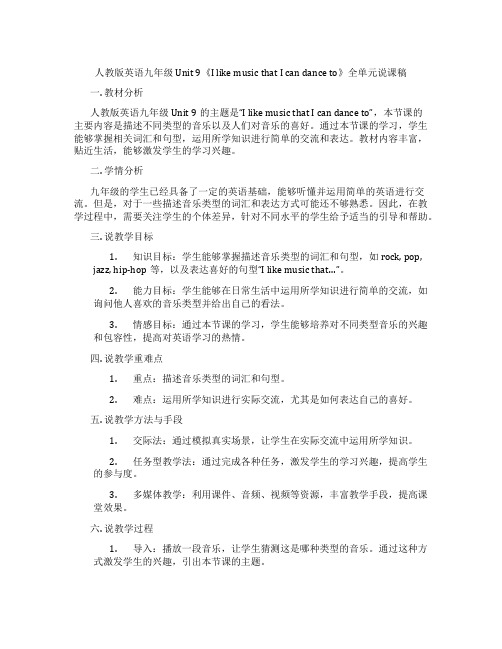人教版九年级英语unit9英文版说课稿(可编辑修改word版)
人教版九年级英语全册Unit9SectionB(3a~SelfCheck)说课稿

2.与学生进行交流,获取他们的反馈和建议。
反思和改进措施包括:
1.根据学生的反馈和掌握情况,调整教学节奏和难度,确保教学内容符合学生的实际水平。
2.丰富教学活动,增加互动性,以提高学生的参与度和兴趣。
3.定期对教学内容和方法进行回顾,不断优化教学策略,以提高教学效果。
三、教学方法与手段
(一)教学策略
我将采用任务型教学法作为主要教学方法。这一方法的理论依据是建构主义学习理论,它强调学生在真实的语言环境中通过完成任务来构建知识,提高语言运用能力。具体来说,我会设计各种听、说、读、写的任务,如小组讨论、音乐评论、听力填空等,让学生在互动合作中学习,激发他们的主动性和创造性。
板书在教学过程中的作用是帮助学生梳理知识结构,强化重点信息。为确保板书清晰、简洁且有助于学生把握知识结构,我会遵循以下几点:
1.确保关键词汇和句型突出,使用大号字体或加粗。
2.使用箭头和连线来表示知识点之间的逻辑关系。
3.在书写过程中,适时擦除非重点信息,保持板书的整洁和聚焦。
(二)教学反思
在教学过程中,我预见到以下可能的问题或挑战:
(四)总结反馈
在总结反馈阶段,我将引导学生进行自我评价,并提供有效的反馈和建议:
1.让学生回顾本节课所学内容,总结自己在音乐类型和形容词描述方面的掌握情况。
2.组织学生互相评价,发现彼此的优点和不足,相互学习。
3.教师针对学生的表现给予针对性的反馈和建议,指导学生如何改进。
(五)作业布置
课后作业的目的是巩固所学知识,提高学生的自主学习能力。我将布置以下作业:
四、教学过程设计
(一)导入新课
新课导入是激发学生注意力和兴趣的关键环节。我将采用以下方式导入新课:
人教版九年级unit9英语说课稿

Unit 9I like music that I can dance to.说课稿各位领导老师:大家好!今天我说课的主要内容是新目标九年级英语第九单元Unit 9 I like music that I can dance to. 本课的中心话题是音乐和音乐家。
通过谈论音乐使大家感受音乐的美。
我将从教材分析、教学方法、教学过程和教学效果几个方面说课。
一、教材分析(一)教材地位Unit 9的中心话题是音乐,而音乐与我们的生活密切相关,通过本单元的学习,要求学生能够用英语谈论自己喜欢的音乐,和音乐家,并说明为什么。
在谈论这个话题的同时,学习并掌握定语从句。
定语从句在初中教材中是一个很重要的知识点,学好这一单元对后面的学习很有帮助,起着承上启下的作用。
在中招考试中,不但十五个选择题中要涉及这方面的内容,而且在也阅读理解中也有大量的定语从句出现,如果不能够很好地掌握它,势必影响学生今后对阅读文章的理解。
因此,本单元不仅是本册书的重点,在整个初中教学中,他都占着非常重要的地位。
(二)教学目标1、知识目标:学会恰当的使用引导词that ,which ,who2、能力目标1)掌握功能句“What kind of music do you like ? I like music that I can dance to . I love singers who can write their own music.”2)能够自如地谈论自己所喜欢的音乐和音乐家。
3、情感目标:通过学生谈论对音乐和音乐家的好恶,从而使学生学会欣赏音乐的美。
三)重点和难点:1、重点1)本节课的教学重点是学会并掌握先行词为物或者人时,引导词“that ,who ,which”的使用方法。
2)“prefer …to…”的用法3)掌握有关音乐的词汇和相关的词组,能够比较流利地描述自己喜欢的音乐,运用功能句 “What kind of music do you like ? I like music that I can dance to . I love singers who can write their own music.”2、难点结合功能句进行听力练习。
人教版九年级英语Unit 9 When was it invented第一课时 说课稿

Unit 9 When was it invented? 第一课时说课稿一.教材分析1.教材的地位和作用本说课是九年级《go for it》第九单元“When was it invented?”本单元涉及内容是本书当中比较重要的一部分。
被动语态结构及运用是教学中一个难点和重点,也是学生比较不容易理解的部分,因为它是建立在各种时态之上的。
另外通过对我们熟悉经常使用的发明物的历史来开阔眼界,丰富学生的阅历,使学生养成勤于思考,善于总结的好习惯。
2.教学目标1)知识目标扩容新单词,提高阅读能力。
理解和良好运用被动语态。
2)技能目标能谈论重要发明的历史及用途,能针对各项发明的用处及特点,发表自己的看法,并说明理由。
3)情感目标使学生懂得人类的科学发明创造了丰富的物质文明。
培养学生的创造发明的能力和愿望3.教学重点掌握一般过去时的被动语态4.教学难点弄清主动语态与被动语态的差异,通过练习和运用加以巩固二.学情分析1.初中生的抽象能力较低,形象思维能力强。
但注意力容易分散。
本单元通过多媒体课件和教师亲和力的语言,增强兴趣和注意力。
2.初中生的学习心理特点1)兴趣对英语普遍感兴趣,求知欲盛。
2)记忆对刺激记忆手段多的知识记忆深刻,遵从记忆规律。
3)评价主要通过他人评价初步形成对自己的评价,所以很在乎他人的评价。
同时自我意识不断增强。
因此在本课教学过程中,注意采用任务型教学为主,通过任务和不同的评价方式,提高学生参与意识。
3.初三上学期学生有较明确的学习动机和态度。
本单元通过发明为载体,各种发明和发明家激励学生求知的欲望。
三.教法渗透1、教学设计思路与教材处理:《新目标英语》中的具体语言目标是通过各种各样的Tasks来实现的;学生需要运用具体而特定的行动来完成一定的交际任务。
整个教学过程中,各种语言结构与语言功能与不同的学习任务有机的结合。
任务活动所谋求的效果不是一种机械的语言训练,而是侧重在执行任务中学生自我完成任务的能力和策略的培养;重视形式在完成任务过程中的参与和在交流活动中所获得的经验。
新目标九年级-第九单元-全英说课稿

Lesson TalkGo for it!Book 9,Unit 9 When was it invented?Reading Do you know when basketball was invented?洛龙七实潘向茹Good morning,everyone! I’m very glad to stand here to interpret my lesson. The lesson I'm going to talk about is the last period of Unit 9,Book 9。
Reading Do you know when basketball was invented?I’ll describe my thoughts on teaching this lesson in the following 6 aspects:analysis of teaching material,analysis of students, teaching aids,teaching aims and demands,teaching procedures and teaching feedback.First of all,I'd like to give some analysis of the material and the students. This material is from Go for it! Book 9,Unit 9When was it invented?The language goal of this unit is to “Talk about the history of inventions。
”In this unit, students will get in touch with the passive voice, which is a new grammar。
英语人教版九年级全册unit9 教案设计

Unit 9 Section B 2a-2cClass Type ReadingObjectives 1.To understand the passage about Abing and his music Erquan Yingyue.2.To introduce the story about Abing and his music toothers who want to know.Key structure 1.What kind of musical instruments did Abing play? —He could play many instruments, but he is best known for playing the erhu.2.What kind of music/ movie do you like best?Difficulties How to retell the story of Abing;Vocabulary Sadness, pain, reflect, perform, pity, total, master, praise, wound, painfulmake a list, be recorded for, in totalPeriods 1ProcedureStep 1 Lead-in Free talk.1.Do you like music?2.What kind of music do you like?3.Do you like Chinese folk music?4.Do you know any Chinese musical instruments?Step 2 Brainstorm.Show Ss the pictures of Chinese musical instruments. Step 3 Guessing game.Do you know the name of the music?What is the name of the musical instrument?Step 4 Brainstorm.Introduce to Ss about the music “Erquan Yingyue” and itsauthor “Abing”.Step 5 Activity 2b.Look at the picture and guess the answers of the questionsin 2b.Read the passage quickly and check the answers. Step 6 Activity 2c.Read again and complete the chart.Step 7 Listen to the tape then fill in the blanks.Step 8 SummaryStep 9 Homework板书设计Unit 9 I like music that I can dance to.Section B 2a – 2ca folk musician Erquan YingyueAbinglived a hard life musical skills。
人教版英语九年级Unit9《IlikemusicthatIcandanceto》全单元说课稿

人教版英语九年级Unit 9《I like music that I can dance to》全单元说课稿一. 教材分析人教版英语九年级Unit 9的主题是“I like music that I can dance to”,本节课的主要内容是描述不同类型的音乐以及人们对音乐的喜好。
通过本节课的学习,学生能够掌握相关词汇和句型,运用所学知识进行简单的交流和表达。
教材内容丰富,贴近生活,能够激发学生的学习兴趣。
二. 学情分析九年级的学生已经具备了一定的英语基础,能够听懂并运用简单的英语进行交流。
但是,对于一些描述音乐类型的词汇和表达方式可能还不够熟悉。
因此,在教学过程中,需要关注学生的个体差异,针对不同水平的学生给予适当的引导和帮助。
三. 说教学目标1.知识目标:学生能够掌握描述音乐类型的词汇和句型,如rock, pop,jazz, hip-hop等,以及表达喜好的句型“I like music that…”。
2.能力目标:学生能够在日常生活中运用所学知识进行简单的交流,如询问他人喜欢的音乐类型并给出自己的看法。
3.情感目标:通过本节课的学习,学生能够培养对不同类型音乐的兴趣和包容性,提高对英语学习的热情。
四. 说教学重难点1.重点:描述音乐类型的词汇和句型。
2.难点:运用所学知识进行实际交流,尤其是如何表达自己的喜好。
五. 说教学方法与手段1.交际法:通过模拟真实场景,让学生在实际交流中运用所学知识。
2.任务型教学法:通过完成各种任务,激发学生的学习兴趣,提高学生的参与度。
3.多媒体教学:利用课件、音频、视频等资源,丰富教学手段,提高课堂效果。
六. 说教学过程1.导入:播放一段音乐,让学生猜测这是哪种类型的音乐。
通过这种方式激发学生的兴趣,引出本节课的主题。
2.新课呈现:通过课件展示不同类型的音乐,如rock, pop, jazz, hip-hop等,同时呈现相应的词汇和句型。
3.操练环节:让学生分组,互相练习使用所学词汇和句型进行交流,教师巡回指导。
初三英语说课稿:Unit 9 Section B
初三英语说课稿:Unit 9 Section B一、教学背景本篇教案是初三英语课程教学中的 Unit 9 Section B,本节课的主要教学内容为掌握英语的修辞格——比喻。
此外,本课还将进一步巩固和提高学生的综合语言运用能力和语言综合素质,让学生在学习中感受到英语的魅力和多样性,从而激发学生的学习兴趣和探究欲。
二、教学目标1. 知识目标1.掌握并理解英语修辞格——比喻的基本概念和形式;2.能够识别和运用比喻修辞格;3.活用所学的语言知识和技能,通过交际实践,能够在实际生活中应用英语。
2. 技能目标1.提高学生的阅读理解能力、表达能力和口语交际能力;2.提高学生的归纳总结和分析判断的能力;3.培养学生的探究精神和创新思维能力。
3. 情感目标1.培养学生热爱、重视和认真对待英语学习的态度和意识;2.提高学生对生活和文化的理解和欣赏水平;3.培养学生的团队合作和交流能力。
三、教学重点和难点1. 教学重点1.掌握比喻的基本概念和形式;2.能够识别、理解、运用比喻。
2. 教学难点1.掌握比喻的使用技巧和效果以及与其他修辞格的区别;2.能够在阅读中灵活运用比喻。
四、教学过程1. Step 1:导入新课1.利用图片和视频展示比喻在日常生活中的使用,让学生初步认识比喻的基本概念和形式;2.引用生活中的例子,让学生更加真切地感受到比喻的魅力。
2. Step 2:讲授认知1.导入课文、介绍比喻的特点和效果;2.解释比喻在阅读中的使用方法,并结合实例演示;3.学生跟随老师的示范创作自己的比喻,加深对比喻的理解和掌握。
3. Step 3:实践运用1.分组合作,在语境中完成课文中的对话;2.集体讨论和反思,分享每组完成的作品;3.分享前请学生自行检查、评价各自的作品,并让学生进行修改和完善。
4. Step 4:总结回顾1.总结比喻的基本概念和形式;2.通过学生的分享和讨论,总结比喻的使用技巧和效果;3.总结本节课的学习内容和收获。
人教版九年级英语《Unit 9I like music that I can dance to. 》
人教版九年级英语《Unit 9I like music that I can dance to. 》说课稿1一. 教材分析人教版九年级英语《Unit 9 I like music that I can dance to.》是本单元的第一课时,主要介绍关于音乐的不同类型以及人们对于不同类型音乐的喜好。
通过本节课的学习,学生能够掌握关于音乐类型的词汇,如rock, pop, jazz, classical等,同时能够运用目标句型“I like…”来表达自己对音乐的喜好。
本节课的主要句型结构为“I like music that I can dance to.”,旨在让学生能够运用该句型来描述自己对音乐的选择。
二. 学情分析九年级的学生已经具备了一定的英语基础,对于日常生活中的基本词汇和句型已经有了一定的掌握。
但是,对于一些关于音乐类型的专业词汇,他们可能较为陌生。
此外,对于句型“I like music that I can dance to.”的运用,他们可能还需要一定的引导和练习。
因此,在教学过程中,我们需要注重词汇的讲解和句型的操练。
三. 说教学目标1.知识目标:学生能够掌握关于音乐类型的词汇,如rock, pop, jazz,classical等;学生能够运用目标句型“I like…”来表达自己对音乐的喜好。
2.能力目标:学生能够运用句型“I like music that I can dance to.”来描述自己对音乐的选择。
3.情感目标:通过本节课的学习,学生能够培养对音乐的热爱和欣赏能力。
四. 说教学重难点1.重点:掌握关于音乐类型的词汇,如rock, pop, jazz, classical等;运用目标句型“I like…”来表达自己对音乐的喜好。
2.难点:运用句型“I like music that I can dance to.”来描述自己对音乐的选择。
五. 说教学方法与手段1.教学方法:采用任务型教学法,让学生在实践中学习,提高他们的语言运用能力。
九年级英语 Unit 9 教师课堂讲解讲义教案 人教新课标版 教案
Unit 9 Have you ever been to an amusement park?一、教学内容1. 教学重点:单词短语句子(详见后)2. 教学难点:1.现在完成时; 2.have been to 与have gone to3. 教学细节:◆导入:复习U6现在完成进行时,引出本单元标题。
I have been skating for five hours.→①I have been……… for five hours.↓have/has+V._ed②I…… been skating for five hours.↓be(am/is/are)+V._ing◆现在完成时:1.表示(1)过去发生或已经完成的某一动作或状态对现在造成的影响或结果。
→强调对现在的影响或结果。
eg. -Have you had your breakfast?-Yes, I have. /No, I haven’t.(2)过去某一时刻开始的动作或状态一直持续到现在。
→强调动作的持续性。
→肯定句中常用延续性动词;常与“for+一段时间”、“since+表示过去的时间点”、“since+从句”连用。
eg. I have lived in Kunming for ten years.I have already bought a new bike. (√)I have bought a new bike for a week. (×)I have had a new bike for a week. (√)2.构成(1)肯定句:主+have/has+V._ed+其他. (2)否定句:主+have/has+not+V._ed+其他.Yes,主+have/has.No,主+haven’t./hasn’t.(3)一般疑问句:Have/Has+主+V._ed+其他?(4)特殊疑问句:特殊疑问词+ have/has+主+V._ed+其他?(删除被提问部分)eg. I have finished my work.I haven’t finished my work.Have you finished your work?What have you done?3.动词的过去分词:(1)如果一个动词的过去式是规则变化的,那么它的过去分词形式与过去式形式相同。
人教版九年级全册Unit 9 I like music that I can dance说课课件
VⅡ Teaching procedures
Step V After reading
Q: How do you make a choice of movies?
Factors
kind scores in Douban music director actor/actress dialog ...
Purposes: Train students’ ability of picture
Analytical level
Students have the ability to analyze the passage on the basis of long-term cultivation of reading habit and strategy.
Affection level
1. Have the similar experiences. 2. Be interested in entertaiment. 3.Be glad to study in a team.
Purpose : To reach the emotion objectives.
Kinds
Descriptions
Feelings after watching
cartoons and comedies
dramas documentarie
s
have funny dialog have a happy ending characters not perfect but try their best to save their problems
01 02
04 03
Students can: 1.understand the passage; 2.express the preference using attributive clauses. 3.finish the tasks in class.
- 1、下载文档前请自行甄别文档内容的完整性,平台不提供额外的编辑、内容补充、找答案等附加服务。
- 2、"仅部分预览"的文档,不可在线预览部分如存在完整性等问题,可反馈申请退款(可完整预览的文档不适用该条件!)。
- 3、如文档侵犯您的权益,请联系客服反馈,我们会尽快为您处理(人工客服工作时间:9:00-18:30)。
3) Scan for specific information efficiently
Teaching Difficult Points
1) Identify main ideas and
supporting details.2) Develop reading skills by noting
specific details
Name: _________
Date of birth: __________
Hometown: ___________
Profession: ____________
Musical instruments: _________________
The number of pieces: ___________
2. Ability Objects 1) Have a fast reading for basic information. 2) Skim for the main idea for each paragraph. 3) Scan for spec ific and detailed information. 4) Express their preferences freely using the target language.
I. Analysis of the teaching material
i) Status and function
Play an input role for intensive reading. Express preferences about t raditional Chinese music. It gives Ss much practice in reading and writing.
4. Teaching important and difficult points
Teaching important Points 1).Have aof the whole text 2) Skim
for the main idea of each paragraph such as topic sentence.
3) Express their preferences freely based on the
information they have read.
5.Teaching aids A tape recorder and Multi-media.
II. Analysis of the students
Abing’s popularit y
Paragraph 3
Writer’s feelings
Step 2. Read Paragraph 1 and try to finish the mind map.
moved
源:学科网]
The music was________ but I sensed a strong ________ and ________. It was one of the _____________________ __that I’ve ever heard.
A: What kind of musical instruments did Abing play?
B: He could play many instruments, but he is best
known for playing the erhu.
A: ……
B: ……
Step 2.Discussion: Watch a video. Listen to the music Er quan Yingyue
IV.Guide of studying ways
1. Stimulate students’ learning interest and discussion.
2. Help students develop efficient reading skills.
V.Teaching procedures Pre-reading: Step 1.Free talk: Show some pictures. Talk
III. Teaching methods
In this class, I’ll mainly use the following teaching methods: 1. Audio-visual teaching method(直观教学法)( set the scene/ predict) 2. Communicative teaching method( discussion, reproduction (再现)and summary) 3. Task-based teaching method( reading comprehension, activity organization)
The most famous piece: ________________
Important events:
★His mother died when __________________.
★Abing was known for his musical ability by________.
★He developed a serious illness and became blind after _P_o_s_t_-_r_e_a_d_i_n_g_:__. ★StHeep l1i.vePdaiorn wtohrek:street and played music to make money for
life______.
______________.
For
several
years,
he
_______________________________________.
When he was very young, his mother _________.
By age 17, Abing was known for _______. _________________.
Unit9 I like music that I can dance to
Section B Sad and beautiful No.3 Junior High School 郝拾平
Hello, everyone! I am Mr. Hao. It’s my great honor to stand h ere to share my teaching ideas with you. Today I am going to talk about Section B Sad but beautiful. My presentation include s six parts: analysis of the teaching material, analysis of the stu dents, teaching methods, guide of studying ways, teaching proce dures and teaching reflections.
ii) Teaching aims and demands
1. Knowledge Objects 1) Know more about different traditional musical instruments in China. 2) Learn about the story Abing a nd his famous art pieces. 3) Use curriculum words and useful e xpressions correctly.
1) Have grasped some words related to the topic. 2) Have the ab ility to use the target language in reading. 3) Own the skills for reading. 3) Desire to know about Chinese culture.
[来
I almost _____as I listened. Step 3. Read Paragraph 2 and complete the following time shaft.
In
1893
Abing
was______________.
_A_f_t_e_r__h_i_s__f_a_t_h.er died, Abing’s
about Chinese musical instruments and famous pieces of music that are played on these instruments. Step 2.Presentation: Watch a video. Listen to the music Erquan Yingyue for the first time. Arouse students’
________________. Post-reading:
Step1. Pair work: Make a conversation. Student A is a
foreign visitor who is interested in Abing and his music.
Student B is a Chinese student who knows about Abing.
interest to know about Abing.
While-reading: Step 1. Skim the passage and match the main
ideas with the paragraphs.
Paragraph 1
Abing’s life(poor/hard)
